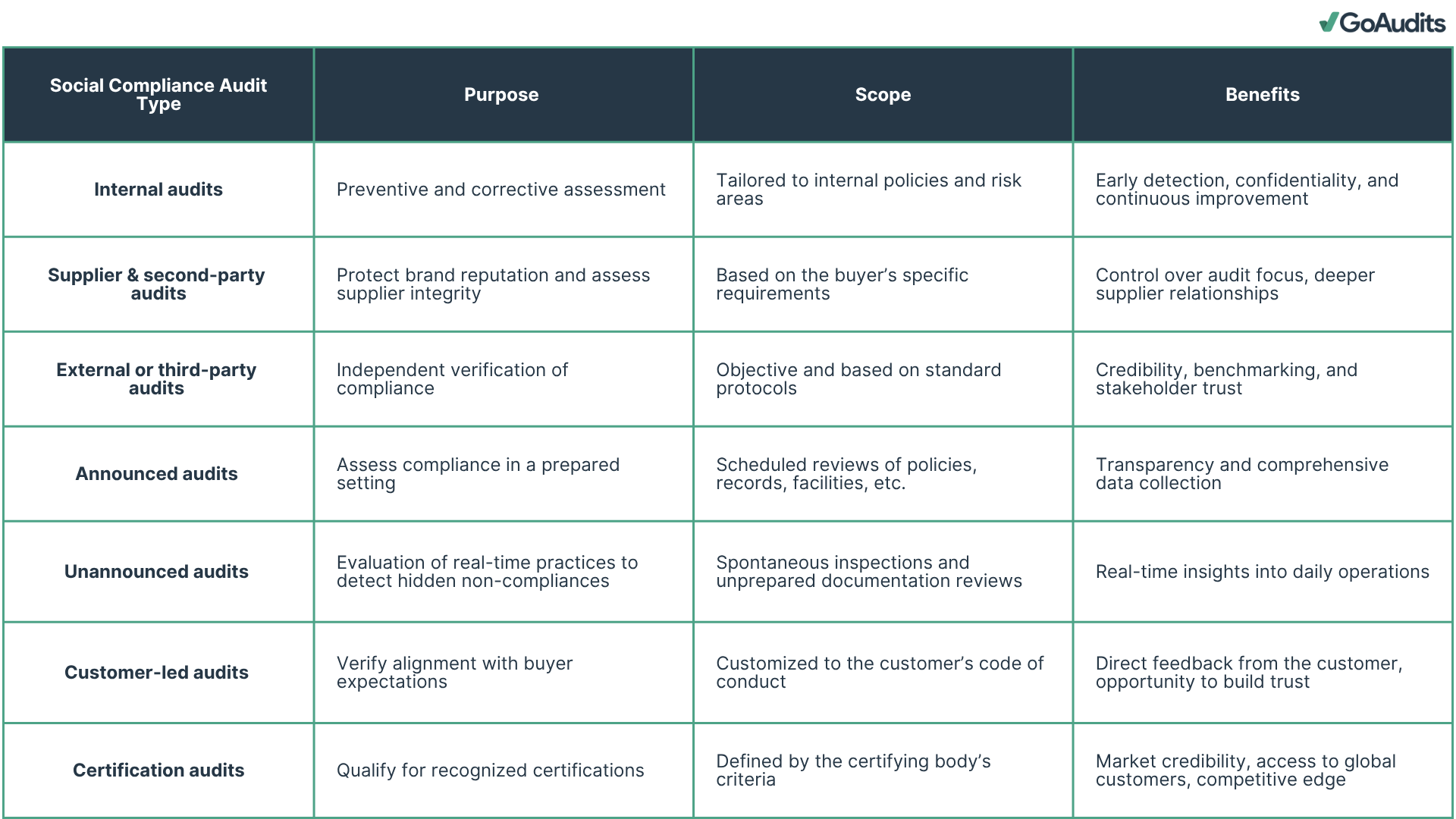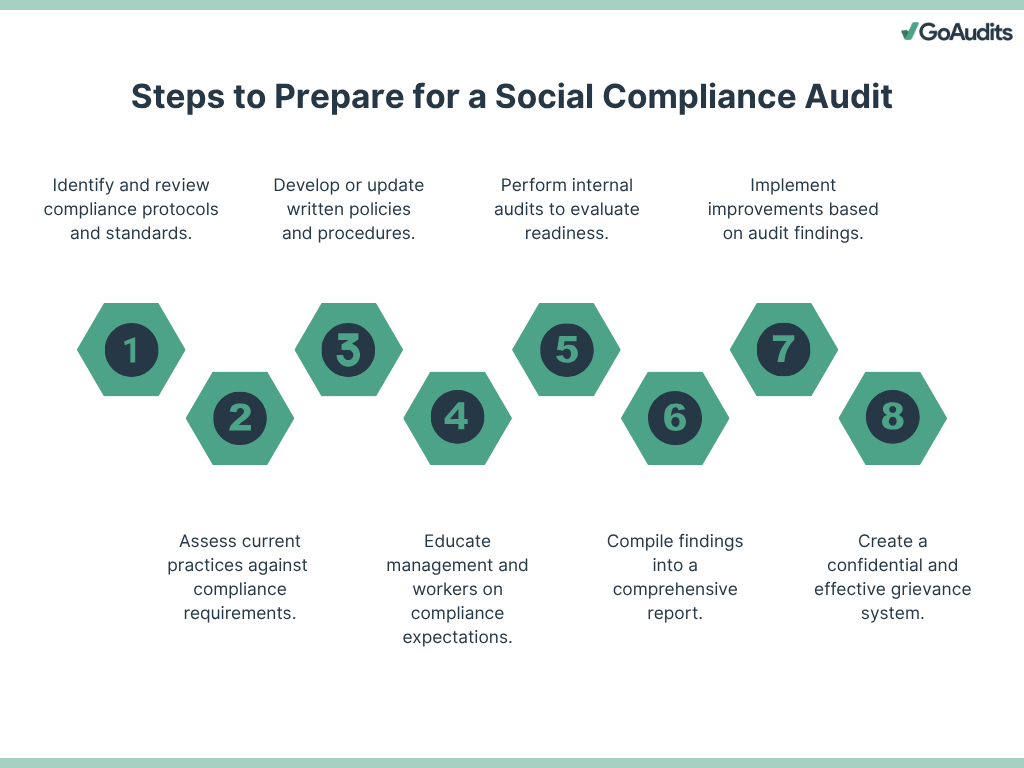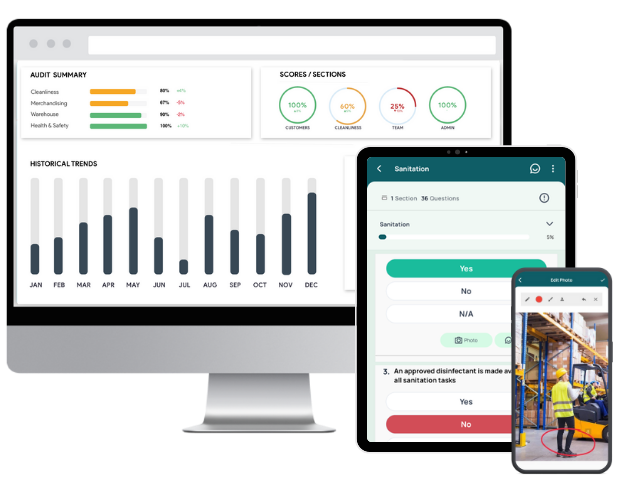Social and ethical audits have become essential for organizations committed to upholding integrity across their operations and supply chains. They help detect hidden risks, uphold labor standards, and drive accountability in real-world working conditions. Social compliance audits reveal critical compliance gaps that internal reviews often overlook. Independent verification offers impartial insights, enabling quick remediation and strengthening the foundation for long-term transparency. More than just identifying problems, these audits support your alignment with internal codes of conduct, international frameworks, and emerging global regulations. They demonstrate your organization’s commitment to ethical conduct, build trust with stakeholders, and reinforce a culture of continuous improvement, ensuring your business practices reflect the values you stand for while minimizing reputational and operational risk.
This article will explore social compliance audits in detail, including their importance, different types, areas covered, steps to prepare for them, and more.
- What are Social Compliance Audits?
- Key Areas Assessed During Social Compliance Audits
- Types of Social Compliance Audits
- Global Social Compliance Audit Standards & Frameworks
- How to Prepare for Social Compliance Audits?
- Perform Internal Audits with GoAudits to Prepare for Social Audits
- What are Social Compliance Audit Reports Important?
- How to Write a Social Compliance Audit Report
What are Social Compliance Audits?
Social compliance audits are systematic evaluations that assess a company’s adherence to labor laws, ethical practices, and social responsibility standards. These audits examine working conditions, employee rights, health and safety measures, fair wages, working hours, and the absence of forced or child labor. The goal is to ensure that a company’s operations, and those of its suppliers, meet both local regulations and human rights benchmarks, international standards, and the company’s own codes of conduct.
If you operate within global supply chains, partner with international buyers, or manufacture goods for export, social compliance audits are essential. Brands, retailers, and sourcing companies require them to verify ethical standards across their value chains. Manufacturers, particularly in sectors like textiles, electronics, agriculture, and consumer goods, must perform these audits to maintain partnerships, enter new markets, or comply with buyer codes of conduct.
These audits are performed:
- Before onboarding new suppliers
- Periodically, as part of ongoing compliance monitoring
- Following major incidents or complaints related to labor practices
- When entering new business agreements requiring ethical sourcing assurance
Social compliance audits are typically conducted by independent third-party auditing firms, specializing in labor and ethical standards, ensuring objectivity and credibility. You must choose a firm based on the audit standard required by your buyer or market regulations.
Why are Social Compliance Audits Important?
Conducting regular social audits offers a range of benefits that go far beyond compliance.
- Protect human rights across your supply chain by evaluating working conditions, wages, health and safety, and anti-discrimination policies.
- Prevent legal and financial risks by identifying non-compliance early, helping you avoid lawsuits, fines, and import restrictions.
- Preserve your brand’s reputation by addressing labor issues proactively before they escalate into public scandals.
- Enhance supply chain transparency by tracing how products are made, from raw materials to finished goods, for more ethical decision-making.
- Build trust with stakeholders by verifying responsible practices through independent audits, reinforcing your company’s ethical commitments.
- Boost worker morale and efficiency by ensuring fair treatment, safe conditions, and respect for labor rights, which improves overall productivity.
- Meet mandatory standards set by retailers, governments, and NGOs through verified documentation of social compliance.
- Drive long-term improvement by using audit insights to benchmark progress and implement higher labor standards year over year.
Key Areas Assessed During Social Compliance Audits
Social compliance audits cover several core areas of responsible business conduct. Here’s a breakdown of the key focus areas:
Labor Practices
Auditors closely examine how your business manages labor. They review wage structures, working hours, contracts, overtime practices, and leave policies. The focus remains on compliance with local labor laws and international standards like those set by the International Labour Organization (ILO). Particular attention is given to fair compensation, protection against forced or child labor, and freedom of association.
👉 Drawing on data from the Sedex platform, covering over 100,000 social audits across 158 countries over five years, clear patterns have emerged around forced labor indicators. Alarmingly, multiple indicators of forced labour are present in 36% of audits. These indicators are more prevalent in countries identified as high risk for labor rights violations.
Moreover, the lower tiers of supply chains, where the visibility and influence of buying companies diminish, tend to report more forced labor indicators. One of the most common signals of forced labor found in these audits is the frequent use of excessive overtime. This reflects a broader issue where workers are subjected to conditions that compromise their health, well-being, and freedom of choice.
Human Rights
Respect for human rights is a fundamental requirement. Social audits assess how your company safeguards employee dignity and protects against discrimination, harassment, and abuse. Review includes grievance mechanisms, disciplinary procedures, and equal opportunity practices. The aim is to ensure that every worker is treated fairly, regardless of race, gender, religion, or background.
Health and Safety
Occupational health and safety (OHS) is a non-negotiable component. Social audits evaluate workplace conditions, safety protocols, emergency preparedness, equipment maintenance, and training programs. Compliance with local safety regulations and global standards such as ISO 45001 is often expected. Proper documentation, hazard controls, and injury records are essential to demonstrate a strong safety culture.
👉 Free Resources
GoAudits OHS software offers a wide range of occupational health & safety checklists to simplify OHS audits and inspections and ensure full compliance.
→ OHS Workplace Inspection Checklist
→ Office OHS Checklist
→ Internal OHSMS Audit (AS/NZS4801:2001)
→ EHS Audit Checklist
→ EHS Standard Operating Procedures
→ OSHA Checklists & Templates
Environmental Responsibility
Ethical audits look beyond operations to environmental impact, focusing on waste management, energy consumption, emissions, water use, and chemical handling. The goal is to confirm that your business operates in an environmentally conscious manner and complies with relevant environmental laws. Practices that reduce the ecological footprint and promote sustainability are highly encouraged.
👉 Free Resources
With GoAudits, you can access digital checklists to support environmental compliance and sustainability efforts and align your environmental management system with international standards. Some of these checklists are:
→ Environmental Audit Checklist Template
→ Environmental Inspection Checklist
→ ISO 14001 Self-Assessment Checklist
→ ISO 14001 Requirements Checklist
Transparent Governance
Strong governance underpins ethical compliance. Social audits assess management systems, internal policies, documentation controls, and reporting practices. Transparency in decision-making, clear roles and responsibilities, and traceability of records are essential. The presence of regular internal audits, training programs, and accountability mechanisms also plays a crucial role.
Subcontractor and Supply Chain Management
Auditors review how you vet, monitor, and manage subcontractors and suppliers across your supply chain. This includes written agreements, audits of partners, and risk assessments. You must show that your suppliers also meet social compliance standards, especially concerning labor rights and safety. Due diligence procedures are key to preventing violations downstream.
👉 Explore the GoAudits library of supply chain & logistics audit checklists and learn how to strengthen your supply chain and logistics processes with our blog on supplier quality management. Use the GoAudits supplier audit app to perform streamlined assessments with a free logistics audit checklist and supplier audit checklist for the food industry, ensuring consistent standards across your supply network.
Anti-Bribery, Integrity, and Overall Business Ethics
Ethical audits examine ethical conduct in every aspect of your business. It covers areas like anti-bribery policies, conflict-of-interest declarations, whistleblower protections, and fraud prevention mechanisms. Clear codes of conduct, employee training, and enforcement processes are expected. Ethical lapses can damage reputations and result in failed audits, even if other areas are compliant.
Types of Social Compliance Audits
Here are some of the main audit types:
1. Internal Audits
Internal audits are conducted by your organization’s own compliance or audit team. These audits allow you to assess internal practices, identify non-conformities, and correct issues before external scrutiny. They typically follow your company’s code of conduct or relevant standards. Use internal audits to foster a culture of accountability and ensure operations align with your values.
2. Supplier or Second-Party Audits
Second-party audits involve evaluating a supplier’s facilities against your standards. Conducted by your team or designated representatives, they help ensure your partners uphold ethical labor, safety, and environmental practices. Second-party audits are instrumental in enforcing contractual obligations and strengthening supply chain transparency.
3. External or Third-Party Audits
Independent third-party auditors carry out these evaluations. They follow globally recognized frameworks such as SA8000, Sedex SMETA, or WRAP. Because they’re impartial, these audits carry high credibility with stakeholders. Rely on third-party audits for unbiased assessments, particularly when public reporting or certifications are required.
4. Announced vs Unannounced Audits
Announced audits are scheduled in advance, allowing time for preparation. In contrast, unannounced audits are conducted without prior notice to assess actual working conditions. A balanced approach, using both types, often yields the most accurate picture of ongoing compliance.
5. Customer-Led Audits
These are initiated and executed by clients or buyers. Customers evaluate your compliance with their own standards, typically as part of vendor approval or risk mitigation processes. Proactively addressing issues identified in these audits can help solidify long-term partnerships.
6. Certification Audits
Certification audits are formal evaluations required to obtain or renew a compliance certification, such as ISO 45001, SA8000, or Fair Trade. They follow strict guidelines set by certifying bodies. Engage in certification audits to demonstrate your commitment to internationally accepted labor and ethical practices.

Global Social Compliance Audit Standards & Frameworks
Below is a comprehensive overview of key global audit standards and frameworks:
1. Sedex Members Ethical Trade Audit (SMETA)
SMETA is an audit methodology developed by Sedex to assess responsible business practices across supply chains. It combines best practices from existing ethical audit techniques, notably the ETI Base Code and ILO conventions.
Pillars:
- 2-Pillar Audit: Focuses on Labor Standards and Health & Safety.
- 4-Pillar Audit: In addition to areas covered under pillar 2, it includes Environmental Assessment and Business Ethics.
Audit findings include non-compliances, observations, and a corrective action plan. They are uploaded to the Sedex platform, allowing suppliers to share results with multiple customers, promoting efficiency and transparency.
👉 Free Resources
GoAudits offers free and customizable checklists to help you perform internal audits and prepare for SMETA 2-pillar and SMETA 4-pillar audits. You can sign up for free and start using these checklists.
→ SMETA Audit Checklist
→ SMETA 6 1 4-Pillar Audit Checklist
→ SMETA 7 0 Audit Checklist for 4-Pillar
→ SMETA 7 0 2-Pillar Audit Checklist
2. Social Accountability International (SA8000)
SA8000, developed by Social Accountability International (SAI), is one of the most established social certification standards, providing a robust framework to improve social performance in factories and facilities across sectors. It focuses on fair treatment of workers based on international human rights norms.
Core elements include:
- No child labor
- No forced or compulsory labor
- Safe and healthy working conditions
- Freedom of association and the right to collective bargaining
- No discrimination
- No harsh or inhumane treatment
- Reasonable working hours
- Fair remuneration
- Management systems for continuous improvement
SA8000 differs from other international social standards by being a certifiable, third-party-audited framework focused specifically on labor rights and workplace conditions, offering a comprehensive and globally applicable management system for ethical performance that is more rigorous and systematic than typical codes of conduct or risk-based.
It is grounded in international human rights and labor norms, mandates continuous improvement, and is recognized for its effectiveness in addressing human resources management issues within organizations and supply chains. Other standards, such as ISO 26000, provide broader, non-certifiable guidance and place greater emphasis on stakeholder engagement or allow companies more flexibility in defining their own scope of social responsibility
3. Worldwide Responsible Accredited Production (WRAP) Code of Conduct
WRAP is an independent, non-profit certification program dedicated to promoting ethical, humane, and lawful manufacturing, primarily within the apparel, footwear, and sewn products industries. Certification provides assurance of social compliance and enhances credibility in international trade.
The 12 principles of WRAP include:
- Compliance with local laws and workplace regulations
- Prohibition of forced labor
- Prohibition of child labor
- Prohibition of harassment or abuse
- Compensation and benefits
- Working hours
- Prohibition of discrimination
- Health and safety
- Freedom of association and collective bargaining
- Environmental protection
- Customs compliance
- Security
4. Amfori Business Social Compliance Initiative (BSCI)
Amfori BSCI offers a standardized approach to improving social performance in global supply chains. It is not a certification scheme, but rather a continuous improvement system. It’s based on the Amfori BSCI Code of Conduct and includes 13 performance areas. Some of the most important ones are:
- Freedom of association
- Fair remuneration
- No child labor
- Ethical business behavior
- Health and safety
- Working hours
- Environmental protection
- Audits are conducted as:
- Full or follow-up audits
- Announced, semi-announced, or unannounced
5. International Labour Organization (ILO) Conventions
The ILO sets international labor standards through legally binding conventions and non-binding recommendations. These are foundational to nearly all global compliance standards.
Core ILO conventions are:
- Freedom of Association (No. 87)
- Right to Collective Bargaining (No. 98)
- Elimination of Forced Labor (Nos. 29 & 105)
- Abolition of Child Labor (Nos. 138 & 182)
- Elimination of Discrimination (Nos. 100 & 111)
ILO conventions address critical labor issues such as human rights, wages, hours of work, workplace safety, and social protection. Ratified conventions become legally binding for member states, forming the legal basis for national labor law.
6. Responsible Business Alliance (RBA) Code of Conduct
The RBA Code of Conduct sets global standards for social, environmental, and ethical responsibility, primarily for industries like electronics, automotive, and retail.
Key areas:
| Labor | Freely chosen employment, child labor avoidance, working hours, wages & benefits, humane treatment, non-discrimination, and freedom of association |
| Health & Safety | Occupational safety, emergency preparedness, industrial hygiene, and machine safeguarding |
| Environment | Environmental permits, pollution prevention, and resource efficiency |
| Ethics | Business integrity, anti-bribery and corruption, and data privacy |
| Management Systems | Risk assessment, corrective actions, and supplier responsibility |
The RBA provides a uniform code for improving conditions in global manufacturing and technology supply chains while promoting responsible sourcing.
7. Social & Labor Convergence Program (SLCP)
The SLCP is a multi-stakeholder initiative designed to streamline social audits and eliminate duplication across the apparel, footwear, and textile industries.
Key features include:
- Uses a Converged Assessment Framework (CAF)
- Produces verifiable social and labor data, but does not certify or score
- Enables data sharing between brands, retailers, and suppliers
- Reduces audit fatigue and administrative costs for facilities
SLCP enables stakeholders to shift from compliance reporting to collaborative improvement by facilitating consistent and efficient data collection.
How to Prepare for Social Compliance Audits?
Follow these key steps to prepare effectively:

Understand Social Compliance Audit Requirements
Begin by identifying the specific audit protocol or code of conduct you must comply with. Review local labor laws, international labor standards, and buyer-specific requirements. Understand key areas such as working hours, wages, health and safety, forced labor, child labor, and discrimination. Familiarity with the requirements allows you to align your operations with expected benchmarks from the outset.
Conduct a Gap Analysis
Assess your current practices against the compliance requirements. Conduct a detailed gap analysis to identify non-conformities. This includes evaluating workplace conditions, employee records, safety procedures, and grievance mechanisms. Prioritize findings based on risk and compliance severity. This helps focus your improvement efforts on high-impact areas.
Document Policies and Procedures
Develop or update written policies covering labor practices, safety protocols, and ethical conduct. Ensure procedures are clear, practical, and accessible to all employees. Examples include working hours policy, wage payment procedures, anti-harassment policy, and emergency preparedness plans. Proper documentation demonstrates a transparent and systematic approach during audits.
Train Management and Workers
Educate your management team and workers on compliance expectations, company policies, and their roles during the audit. Training should cover topics such as workplace rights, health and safety, and ethical behavior. Consistent training builds awareness and promotes a culture of compliance across all levels of your organization.
Conduct Mock and Internal Audits
Perform internal audits to evaluate your readiness. Include document checks, worker interviews, and facility walkthroughs. Simulate social audit conditions as realistically as possible. Mock audits help identify potential issues before the official audit. Use these insights to take corrective actions and reinforce accountability.
Prepare, Review, and Share the Audit Report
Once the internal audit is complete, compile findings into a comprehensive report. Highlight strengths, list non-compliances, and detail corrective actions taken. Share the report with relevant stakeholders, including senior management and compliance officers. It fosters trust and ensures all parties are aligned on next steps.
Improve Workplace Conditions
Use audit feedback to implement meaningful improvements. Address deficiencies in infrastructure, safety equipment, working conditions, or worker welfare. Maintain records of upgrades and corrective actions. Sustained improvements not only support compliance but also enhance employee satisfaction and retention.
Establish a Grievance Mechanism
Create a confidential, accessible, and effective grievance mechanism. This allows workers to raise concerns without fear of retaliation. Include multiple reporting channels and clear response timelines. A functional grievance system promotes fairness, accountability, and continuous improvement.
Perform Internal Audits with GoAudits to Prepare for Social Audits
Preparing for social audits demands consistency, accountability, and thorough documentation. GoAudits audit & inspection app is an all-in-one solution designed to streamline your internal audits and readiness processes, ensuring compliance with labor laws, safety standards, and ethical practices.
With GoAudits, you eliminate paperwork, reduce errors, and enhance visibility. It enables you to conduct audits on the go, generate instant reports, assign corrective actions, and analyze audit data, all from one unified system. Whether you’re operating across multiple locations or preparing for a compliance check, GoAudits ensures you’re always inspection-ready.

- Access industry-ready templates or create tailored checklists specific to social compliance. Convert your existing forms into digital checklists, free of cost.
- Conduct audits anytime, anywhere, on smartphones or tablets, even offline. Capture data instantly with photos, annotations, geolocation, and e-signatures.
- Automatically generate branded audit reports at the end of each audit. Reports are customizable and ready to be shared as they already include timestamps, scoring, photos, and user information.
- Assign issues to the responsible team members during the audit. Set due dates, add priority levels, and monitor resolution progress to ensure follow-through.
- Automate task assignments, escalations, and approvals with rules and notifications. Keep everyone informed with real-time alerts and email updates on open actions.
- Use visual dashboards to monitor audit performance and scores across sites or teams. Identify trends, track recurring issues, and generate actionable insights from historical data.
What are Social Compliance Audit Reports Important?
Some reasons why social compliance audit reports are important:
- Confirm adherence to labor laws, global standards, and industry codes with independently verified documentation.
- Detect issues such as wage violations, excessive work hours, or safety lapses that require immediate corrective action.
- Gain visibility into recurring issues and systemic risks, helping you align social compliance with broader business goals.
- Build a historical performance record to measure progress, document remediation, and maintain accountability.
- Show commitment to transparency and ethical practices, strengthening credibility with investors, clients, and partners.
- Compare results between facilities or suppliers to identify best practices and standardize procedures organization-wide.
- Design focused training and corrective plans based on audit findings to prevent future non-compliance.
- Provide credible data to back social responsibility claims and reinforce your sustainability narrative.
How to Write a Social Compliance Audit Report
Here’s how you can structure and write an effective social compliance audit report:
Use a Clear and Structured Format
Start with a clean, professional layout. Use defined sections and subheadings to help the reader scan quickly. Include a cover page, table of contents, executive summary, and clearly labeled sections for findings, analysis, and recommendations.
Gather and Present Relevant Information
Include all pertinent company details such as the audit date, facility name and location, audit team members, and the audited processes. Present accurate and complete data. Ensure information is factual, objective, and backed by documented evidence, giving a comprehensive overview of the facility’s compliance performance.
Define Audit Scope, Purpose, and Methodology
State the purpose of the audit, whether it’s for internal evaluation, client requirement, or third-party certification. Clarify the audit scope, including geographical boundaries, business units, and time frame covered. Describe the methodology used, including document reviews, interviews, and on-site observations. Specify the standards or codes applied.
Highlight Non-Conformities
Document all instances of non-compliance clearly. Specify which standard or regulation was violated, where it occurred, and how. Describe the nature and severity of each non-conformity, supported by evidence such as photos, documents, or interview excerpts. Use consistent terminology to ensure clarity and alignment with compliance standards.
The most common violations found in social compliance audits typically include:
- Child labor: Employing workers below the legal minimum working age.
- Forced labor: Practices such as confiscating workers’ ID cards or passports, restricting the ability to resign freely, or using debt bondage.
- Excessive working hours: Failure to comply with legal limits on working hours and inadequate rest periods.
- Failure to meet minimum wage requirements: Not paying at least the legal minimum wage or failing to provide proper overtime pay.
- Unsafe or unhealthy working conditions: This includes hazardous machinery, poor ventilation, inadequate lighting, lack of emergency exits, and insufficient personal protective equipment (PPE).
- Discrimination and abusive behavior: Evidence of discrimination, harassment, physical punishment, or verbal abuse against workers.
- Lack of freedom of association: Preventing workers from forming or joining trade unions or engaging in collective bargaining.
- Improper documentation: Incomplete or inconsistent records regarding working hours, wages, and employee contracts.
- Environmental violations: Improper waste disposal, air and water pollution, and unsafe handling of hazardous chemicals.
- Bribery and corruption: Attempts to conceal violations through bribery of auditors or authorities.
These violations can lead to failed audits, resulting in loss of certifications, canceled orders, or termination of business relationships.
Detail Other Audit Findings
Provide a summary of other findings beyond non-conformities to prioritize corrective actions and allocate resources effectively. Include:
- Compliance Score: Quantify the level of adherence using a standardized scoring system.
- Root Cause Analysis: Investigate and explain why non-conformities occurred. Look beyond symptoms to identify systemic issues.
- Risk Ratings: Classify findings based on their potential impact and likelihood, using a high-medium-low risk scale.
Develop and Include a Corrective Action Plan
For each non-conformity, outline a specific corrective action. Assign responsibilities, define timelines, and set measurable outcomes. Ensure the plan addresses both immediate fixes and long-term solutions to prevent recurrence.
Attach Supporting Evidence and Documentation
Include all relevant supporting documents in the appendix to ensure transparency and substantiate findings. This might consist of checklists, interview notes, attendance logs, training records, or photographic evidence. Each item should be clearly referenced in the main report.
Finalize and Share the Report
Review the entire document for accuracy, completeness, and objectivity. Remove subjective language and ensure all claims are evidence-based. Once finalized, share the report with relevant stakeholders in a secure and confidential manner. If required, follow up with a debrief or presentation to discuss the findings and next steps.




